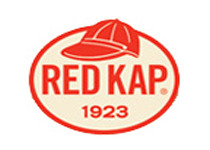Red Kap
Accessories / Apparel
It all started in 1923, when two brothers and a cousin teamed up to sell bib overalls under a sign that read "Harlin Bros. & Williams." Turns out comfort, durability and great service were valued e...
It all started in 1923, when two brothers and a cousin teamed up to sell bib overalls under a sign that read "Harlin Bros. & Williams." Turns out comfort, durability and great service were valued every bit as much back then as they are today, so naturally the business grew quickly. The family soon expanded their catalog to include a line of premium workwear. As they pondered the idea of what to name this new line, one of the founders pulled out his trusty pouch of Red Cap Brazil Smoking Tobacco. The bright red jockey cap on the tobacco label seemed like a perfect icon, and the brothers' own distinctive Red Kap logo was introduced in 1927. An official name change followed in 1939. By this time, the family had continued to diversify even more. They now sold "matched sets" of work pants and shirts, along with the "Go-Getter" line of value-priced chambray shirts. Times were good. Then suddenly, WWII threw the whole country into turmoil. Red Kap did their part, pitching in on the war effort by manufacturing gas mask carriers, combat fatigues and field jackets. All were made to the same high standards America had come to expect from Red Kap. After the war, the company joined forces with a network of laundries to pick up, deliver and supply fresh uniforms to all sorts of businesses. Steady success followed, and by the 1960s, they had realized their dream of becoming a major player in the workwear industry. Today, the Red Kap brand is stronger than ever. Proving once again that comfort, durability and "done right" simply never go out of style.Brand Details
Founder
Alexander F. Harlin
Brand Strategy
Market segment
Mass Market
Core business
Apparel
Targets
Men, Women
